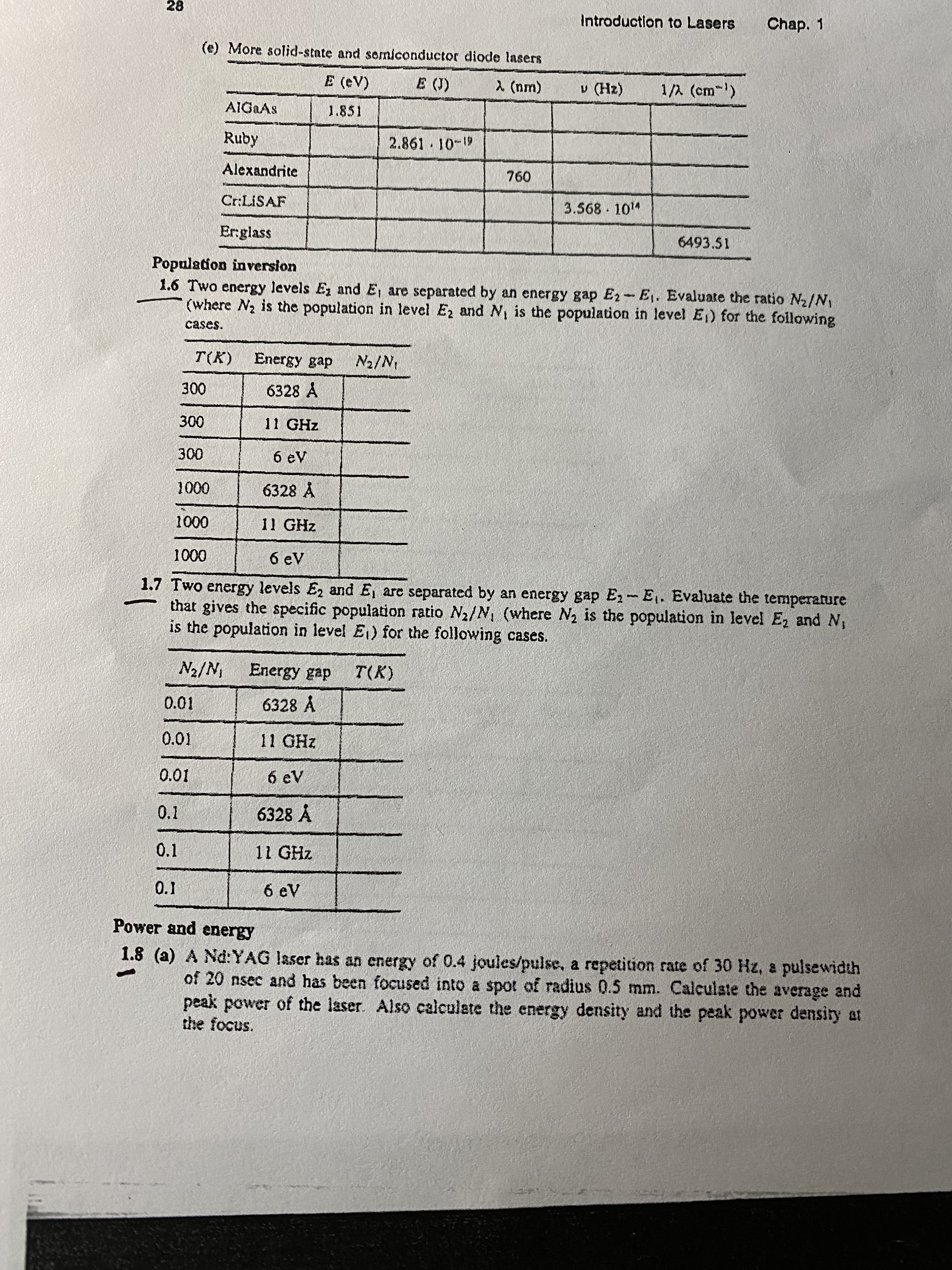28 Introduction to Lasers Chap. 1 (e) More solid-state and somiconductor diode lasers E (eV) E (J) 2 (nm) v (Hz) 1/A (cm-) AIGAAS 1.851 Ruby 2.861 10-9 Alexandrite 760 Cr:LISAF 3.568 10" Er:glass 6493.51 Population inversion 1.6 Two energy levels E, and E, are separated by an energy gap E2-E,. Evaluate the ratio N2/N, (where N2 is the population in level Ez and N, is the population in level E) for the following cases. T(K) Energy gap N2/N 300 6328 A 300 11 GHz 300 6 eV 1000 6328 Å 1000 11 GHz 1000 6 eV 1.7 Two energy levels E, and E, are separated by an energy gap E E. Evaluate the temperature that gives the specific population ratio N2/N, (where N2 is the population in level E, and N, is the population in level E) for the following cases. N2/N Energy gap T(K) 0.01 6328 A 0.01 11 GHz 0.01 6 eV 0.1 6328 A 0.1 11 GHz 0.1 6 eV Power and energy 1.8 (a) A Nd:YAG laser has an energy of 0.4 joules/pulse, a repetition rate of 30 Hz, a pulsewidth of 20 nsec and has been focused into a spot of radius 0.5 mm. Calculste the average and peak power of the laser. Also calculate the energy density and the peak power density at the focus.
28 Introduction to Lasers Chap. 1 (e) More solid-state and somiconductor diode lasers E (eV) E (J) 2 (nm) v (Hz) 1/A (cm-) AIGAAS 1.851 Ruby 2.861 10-9 Alexandrite 760 Cr:LISAF 3.568 10" Er:glass 6493.51 Population inversion 1.6 Two energy levels E, and E, are separated by an energy gap E2-E,. Evaluate the ratio N2/N, (where N2 is the population in level Ez and N, is the population in level E) for the following cases. T(K) Energy gap N2/N 300 6328 A 300 11 GHz 300 6 eV 1000 6328 Å 1000 11 GHz 1000 6 eV 1.7 Two energy levels E, and E, are separated by an energy gap E E. Evaluate the temperature that gives the specific population ratio N2/N, (where N2 is the population in level E, and N, is the population in level E) for the following cases. N2/N Energy gap T(K) 0.01 6328 A 0.01 11 GHz 0.01 6 eV 0.1 6328 A 0.1 11 GHz 0.1 6 eV Power and energy 1.8 (a) A Nd:YAG laser has an energy of 0.4 joules/pulse, a repetition rate of 30 Hz, a pulsewidth of 20 nsec and has been focused into a spot of radius 0.5 mm. Calculste the average and peak power of the laser. Also calculate the energy density and the peak power density at the focus.
Related questions
Question
1.6

Transcribed Image Text:28
Introduction to Lasers
Chap. 1
(e) More solid-state and somiconductor diode lasers
E (eV)
E (J)
2 (nm)
v (Hz)
1/A (cm-)
AIGAAS
1.851
Ruby
2.861 10-9
Alexandrite
760
Cr:LISAF
3.568 10"
Er:glass
6493.51
Population inversion
1.6 Two energy levels E, and E, are separated by an energy gap E2-E,. Evaluate the ratio N2/N,
(where N2 is the population in level Ez and N, is the population in level E) for the following
cases.
T(K) Energy gap
N2/N
300
6328 A
300
11 GHz
300
6 eV
1000
6328 Å
1000
11 GHz
1000
6 eV
1.7 Two energy levels E, and E, are separated by an energy gap E E. Evaluate the temperature
that gives the specific population ratio N2/N, (where N2 is the population in level E, and N,
is the population in level E) for the following cases.
N2/N
Energy gap
T(K)
0.01
6328 A
0.01
11 GHz
0.01
6 eV
0.1
6328 A
0.1
11 GHz
0.1
6 eV
Power and energy
1.8 (a) A Nd:YAG laser has an energy of 0.4 joules/pulse, a repetition rate of 30 Hz, a pulsewidth
of 20 nsec and has been focused into a spot of radius 0.5 mm. Calculste the average and
peak power of the laser. Also calculate the energy density and the peak power density at
the focus.
Expert Solution
This question has been solved!
Explore an expertly crafted, step-by-step solution for a thorough understanding of key concepts.
This is a popular solution!
Trending now
This is a popular solution!
Step by step
Solved in 3 steps with 3 images
